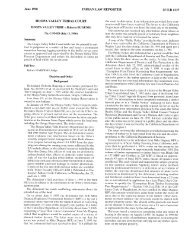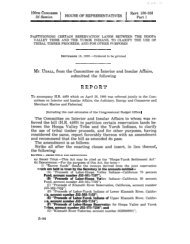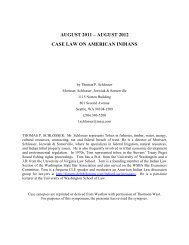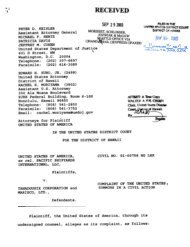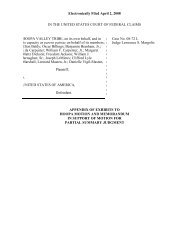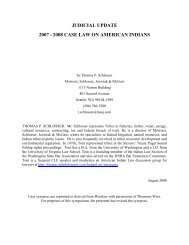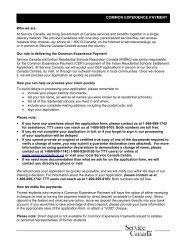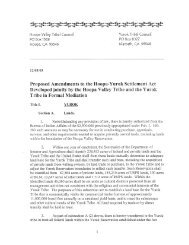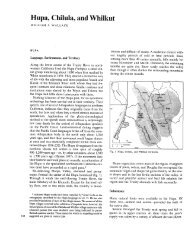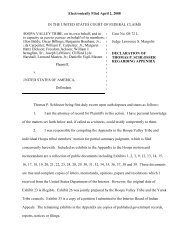Yurok Tribe's Motion to Dismiss U.S. Third Party Complaint
Yurok Tribe's Motion to Dismiss U.S. Third Party Complaint
Yurok Tribe's Motion to Dismiss U.S. Third Party Complaint
Create successful ePaper yourself
Turn your PDF publications into a flip-book with our unique Google optimized e-Paper software.
Case 1:08-cv-00072-TCW Document 39 Filed 11/07/2008 Page 1 of 16<br />
IN THE UNITED STATES COURT OF FEDERAL CLAIMS<br />
HOOPA VALLEY TRIBE, et al., )<br />
)<br />
Plaintiffs, )<br />
) Case No. 08-72 L<br />
v. ) Judge Thomas C. Wheeler<br />
)<br />
THE UNITED STATES OF AMERICA, )<br />
)<br />
Defendant and )<br />
Putative <strong>Third</strong> <strong>Party</strong> Plaintiff )<br />
)<br />
v. )<br />
)<br />
YUROK TRIBE, )<br />
)<br />
Putative <strong>Third</strong> <strong>Party</strong> Defendant. )<br />
)<br />
THIRD PARTY DEFENDANT YUROK TRIBE’S MOTION TO DISMISS<br />
OR IN THE ALTERNATIVE FOR SUMMARY JUDGMENT<br />
The <strong>Yurok</strong> Tribe, by its counsel, respectfully moves <strong>to</strong> dismiss the United States’<br />
<strong>Third</strong> <strong>Party</strong> <strong>Complaint</strong>, or in the alternative for entry of summary judgment in favor of the <strong>Yurok</strong>.<br />
First, let there be no mistake: the <strong>Yurok</strong> fully support the United States’ pending dispositive<br />
motion. The Government’s distribution of the <strong>Yurok</strong> Fund <strong>to</strong> the <strong>Yurok</strong> was not only entirely<br />
lawful but affirmatively mandated by the Hoopa-<strong>Yurok</strong> Settlement Act (“HYSA”). 1/ But even<br />
if the Hoopa Valley plaintiffs’ claim against the United States were <strong>to</strong> be found <strong>to</strong> require trial,<br />
basic principles of trust law preclude any contingent recovery of the <strong>Yurok</strong> Fund from the <strong>Yurok</strong><br />
Tribe or from its members. Thus, the United States’ claim should be dismissed as a matter of<br />
law.<br />
1/ Pursuant <strong>to</strong> the Court’s order dated Oc<strong>to</strong>ber 27, 2008, the <strong>Yurok</strong> will file a response <strong>to</strong> the pending crossmotions<br />
on the Hoopa Valley plaintiffs’ complaint against the United States on November 21, 2008.<br />
\\\DC - 024734/000003 - 2815011 v2<br />
1
Case 1:08-cv-00072-TCW Document 39 Filed 11/07/2008 Page 2 of 16<br />
An immediate dismissal is fully warranted because no purpose is served by<br />
subjecting the <strong>Yurok</strong> <strong>to</strong> the burden of defending the claim brought by the Hoopa Valley Tribe.<br />
Even if the United States had a contingent claim against the <strong>Yurok</strong>, which it does not, there<br />
would be time enough <strong>to</strong> address that claim in the (unlikely) event the United States were found<br />
liable <strong>to</strong> the Hoopa Valley plaintiffs. The United States’ attempt <strong>to</strong> embroil the <strong>Yurok</strong> in this<br />
litigation now serves no legitimate litigation purpose, and risks exacerbating his<strong>to</strong>rical conflicts<br />
between the neighboring <strong>Yurok</strong> and Hoopa Valley Tribes.<br />
Thus, this case should be dismissed because the United States’ third-party claim<br />
against the <strong>Yurok</strong> fails as a matter of law, or in the alternative, because there will be time enough<br />
<strong>to</strong> address it in the unlikely event the United States is found liable for distributing the <strong>Yurok</strong>’s<br />
funds <strong>to</strong> the <strong>Yurok</strong>.<br />
BACKGROUND<br />
The claims in this case relate almost exclusively <strong>to</strong> the Hoopa-<strong>Yurok</strong> Settlement<br />
Act, 25 U.S.C. §§ 1300i et seq. The HYSA in turn arose from, and ultimately resolved, claims<br />
relating <strong>to</strong> the Unites States’ dismal his<strong>to</strong>ry of mistreating both tribes--particularly the <strong>Yurok</strong>.<br />
That his<strong>to</strong>ry is now established beyond debate in court decisions over the years. The facts<br />
material <strong>to</strong> this motion are those relating <strong>to</strong> the recent distribution of the <strong>Yurok</strong> Fund <strong>to</strong> the<br />
<strong>Yurok</strong> under the HYSA and are undisputed. 2/<br />
Establishment of the Reservation. In the 1900s, both the <strong>Yurok</strong> Tribe and the<br />
Hoopa Valley Tribe lived in the same general area in Northern California. In 1876, President<br />
2/ Many of the facts related in this section are found in prior court decisions and in the legislative his<strong>to</strong>ry of<br />
HYSA. The Court may take judicial notice of such facts, and need not convert this motion <strong>to</strong> dismiss in<strong>to</strong> a motion<br />
for summary judgment. Commonwealth Edison Co. v. United States, 46 Fed.Cl. 158 (2000), aff’d 271 F.3d 1327<br />
(2001) (court may take judicial notice of factual findings in legislative his<strong>to</strong>ry); Kawa v. United States., 77 Fed.Cl.<br />
294 (2007) (court may take judicial notice of factual findings in prior judicial decisions); see also Sebastian v.<br />
United States., 185 F.3d 1368, 1374 (Fed. Cir. 1999) (same). The remaining facts are alleged in the complaints of<br />
the plaintiffs and third party plaintiff and are properly considered, and assumed true, on a motion <strong>to</strong> dismiss.<br />
\\\DC - 024734/000003 - 2815011 v2<br />
2
Case 1:08-cv-00072-TCW Document 39 Filed 11/07/2008 Page 3 of 16<br />
Grant set aside a 12-mile square tract of land in Northern California where the Trinity River joins<br />
the Klamath River as the Hoopa Valley Indian Reservation. “Most but not all of the Indians of<br />
the tract, called the Square, were and have been Hoopa Indians.” Short v. United States, 486<br />
F.2d 561 (Ct. Cl. 1973) (Short I). The 1876 executive order did not identify any Indian tribe by<br />
name, nor did it “intimate[ ] which tribes were occupying or were <strong>to</strong> occupy the reservation.” Id.<br />
at 563.<br />
Some years later, in 1891, President Harrison issued an executive order creating<br />
“an enlarged, single reservation incorporating without distinction its added and original tracts<br />
upon which the Indians populating the newly-added lands should reside on an equal footing with<br />
the Indians there<strong>to</strong>fore resident upon it.” Id. at 567. Under the executive order, the boundaries of<br />
the Hoopa Valley Indian Reservation were extended <strong>to</strong> include an adjoining one-mile wide strip<br />
of land on each side of the Klamath River, from the confluence of the two rivers <strong>to</strong> the ocean<br />
about 45 miles away. Id. at 562. Most of the Indians of the added tract, called the Addition<br />
(and sometimes called the “extension”), were and have been <strong>Yurok</strong> Indians, also known as<br />
Klamaths. Id. From 1891 <strong>to</strong> the late twentieth century, the <strong>Yurok</strong>, the Hoopa, and members of<br />
other tribes lived on the single, enlarged reservation.<br />
The Government’s Breach of Trust. The Square was rich in timber resources<br />
and began <strong>to</strong> produce substantial revenues in the 1950s. Id. These revenues were administered<br />
by the Secretary of the Interior as trustee of the beneficial owners. In 1950, the Hoopa Indians<br />
established an organization known as the Hoopa Valley Tribe, whose membership excluded the<br />
<strong>Yurok</strong>. Id. “Beginning in 1955, the Secretary of the Interior, pursuant <strong>to</strong> requests by the Hoopa<br />
Valley <strong>Tribe's</strong> Business Council, distributed the revenues from the timber sales annually in per<br />
capita payments <strong>to</strong> the Indians on the official roll of the Hoopa Valley Tribe, <strong>to</strong> the exclusion of<br />
\\\DC - 024734/000003 - 2815011 v2<br />
3
Case 1:08-cv-00072-TCW Document 39 Filed 11/07/2008 Page 4 of 16<br />
the Indians of the Addition.” Short v. United States, 661 F.2d 150, 152 (Ct. Cl. 1981) (Short<br />
II) 3/ These revenues were substantial: “From March 27, 1957 <strong>to</strong> June 30, 1974, $23,811,963.75<br />
in tribal or communal monies was distributed per capita <strong>to</strong> the [Hoopa Valley] <strong>Tribe's</strong> individual<br />
members.” Short v. United States, 12 Cl. Ct. 36, 41 (1987) (Short IV).<br />
The Short Litigation. In 1963, individual Indians who were excluded from the<br />
Secretary’s distributions (mostly <strong>Yurok</strong>) brought suit against the United States, as trustee and<br />
administra<strong>to</strong>r of the timber resources of the Reservation, “seeking their shares of the revenues<br />
the government had distributed <strong>to</strong> individual Indians of the Reservation.” Short II, 661 F.2d at<br />
152. In 1973, the Court of Claims held that “the Square and the Addition <strong>to</strong>gether constituted a<br />
single reservation, that all the Indians of that Reservation were entitled <strong>to</strong> share in all of its<br />
revenues that were distributed <strong>to</strong> individual Indians (including the timber revenues from the<br />
Square), and that the plaintiffs who were Indians of the Reservation were entitled <strong>to</strong> recover the<br />
monies the government withheld from them.” Id.<br />
Notwithstanding the Court’s clear holding, the Bureau of Indian Affairs continued<br />
<strong>to</strong> distribute the timber revenues only <strong>to</strong> enrolled Hoopa Valley Tribe members and no one else.<br />
See Short v. United States, 28 Fed. Cl. 590, 591 (1993) (Short VI). “After the 1973 decision, the<br />
BIA began <strong>to</strong> distribute only thirty percent of the unallotted Reservation income because it<br />
estimated that Hoopa Valley Tribe members comprised thirty percent of the Indians of the<br />
Reservation.” Id. The BIA retained the remaining seventy percent in an escrow fund, which<br />
came <strong>to</strong> be known as the “Short escrow fund” or the “seventy percent fund.” Id. The escrow<br />
fund grew <strong>to</strong> over $60 million by the time the Court decided Short VI in 1993. Id. at 37.<br />
3/ The official roll of the Hoopa Valley Tribe “limit[ed] enrollment <strong>to</strong> allottees of land on the Square, nonlandholding<br />
‘true’ Hoopas voted upon by the Tribe, and long-time residents of the Square of a prescribed degree of<br />
Hoopa blood, descended from natives of the Square. Short I, 486 F.2d at 562.<br />
\\\DC - 024734/000003 - 2815011 v2<br />
4
Case 1:08-cv-00072-TCW Document 39 Filed 11/07/2008 Page 5 of 16<br />
The Hoopa-<strong>Yurok</strong> Settlement Act. Some 25 years after the Short litigation<br />
began, Congress addressed the issue by enacting the Hoopa-<strong>Yurok</strong> Settlement Act, Pub. L. No.<br />
100-580, 102 Stat. 2924 (codified at 25 U.S.C. §§ 1300i <strong>to</strong> 1300i-11) (1988) (“HYSA” or<br />
“Act”) . The Act explicitly preserved the holdings and final judgment of the Short cases, see 25<br />
U.S.C. § 1300i-3, but it also sought <strong>to</strong> resolve the decades of dispute between the Hoopa Valley<br />
Tribe and the <strong>Yurok</strong> by partitioning the reservation in<strong>to</strong> the Hoopa Valley Reservation (the<br />
Square) and the <strong>Yurok</strong> Reservation (the “addition” along the Klamath River). 25 U.S.C. §<br />
1300i-1(c). The Act also required the Secretary of the Interior <strong>to</strong> establish a “Settlement Fund,”<br />
comprising the Short escrow funds and other monies. 25 U.S.C. § 1300i-3(a).<br />
Pursuant <strong>to</strong> the Act, the Secretary divided the Settlement Fund (the “ Fund”)<br />
between the Hoopa Valley Tribe and the <strong>Yurok</strong> Tribe, roughly in proportion <strong>to</strong> the number of<br />
Indians in each Tribe. See Short VI, 28 Fed. Cl. at 591. 4/ Although the Hoopa and <strong>Yurok</strong><br />
peoples had shared a single reservation for nearly a century, the area allocated <strong>to</strong> the Hoopa, the<br />
Square, was far richer in timber and other resources than the “addition” allocated <strong>to</strong> the <strong>Yurok</strong><br />
Indians. On this, there is no dispute. 5/ And it explains why Congress determined that not only<br />
would the <strong>Yurok</strong> receive a population-based allocation from the Fund, but that “any funds<br />
remaining in the Settlement Fund . . . shall be paid <strong>to</strong> the <strong>Yurok</strong> Tribe and shall be held by the<br />
Secretary in Trust for such tribe.” 25 U.S.C. § 1300i-6(a). 6/<br />
4/ After the initial division, the Act authorized Congress <strong>to</strong> contribute $10,000,000 <strong>to</strong> the Settlement Fund. 25<br />
U.S.C. § 1300i-3(e). The Act also provided for distributions <strong>to</strong> Indians who did not elect <strong>to</strong> join the <strong>Yurok</strong> or Hoopa<br />
Valley Tribe and <strong>to</strong> Indians who wrongfully were left off the Settlement Roll. 25 U.S.C. § 1300i-5(d).<br />
5/ The Hoopa Valley Tribe has acknowledged that over 98 percent of the funds generated on the land and now<br />
part of the Settlement Fund originated from timber taken from the Square, which has since been given <strong>to</strong> the Hoopa.<br />
See Pls’ Am. Compl. 24.<br />
6/ After allocation of the timber-rich square <strong>to</strong> the Hoopa, there is no dispute about the <strong>Yurok</strong>’s need. In the<br />
Select Committee on Indian Affairs Report on the Hoopa-<strong>Yurok</strong> Settlement bill, the Committee recognized that the<br />
<strong>Yurok</strong> Tribe “has not received the majority of services provided <strong>to</strong> other federally recognized tribes,” and “[a]s a<br />
\\\DC - 024734/000003 - 2815011 v2<br />
5
Case 1:08-cv-00072-TCW Document 39 Filed 11/07/2008 Page 6 of 16<br />
The Hoopa Valley Tribe promptly sought and received its allocated share of the<br />
Settlement Fund. The Act required that before either Tribe could do so, it must first submit a<br />
waiver of “any claim . . . against the United States arising out of the provisions of th[e] [Act].”<br />
25 U.S.C. §§ 1300i-1(a)(2)(A) & (c)(4), 1300i-8(d)(2). The HVT executed such a waiver<br />
immediately. On November 28, 1988, the Hoopa Valley Tribe passed a resolution waiving “any<br />
claim the Hoopa Valley Tribe may have against the United States arising out of the provisions of<br />
the Hoopa-<strong>Yurok</strong> Settlement Act.” Resolution of the Hoopa Valley Tribe, 53 Fed. Reg. 49,361-<br />
01, 49,361-62 (Bureau of Indian Affairs Notice Dec. 7, 1988); Pls’ Am. Compl. 34. On the<br />
strength of this waiver of rights, the Hoopa Valley Tribe received its full allocated distribution<br />
from the Settlement Fund thereafter.<br />
Since that time, the Department of the Interior has consistently maintained that<br />
“the Hoopa Valley Tribe has already received its portion of the benefits under [HYSA] and is not<br />
entitled <strong>to</strong> further distributions from settlement funds under the provisions of the act.” N.<br />
McCaleb Testimony, S. Hrg. 107-648 (Aug. 1, 2002). The rest of the monies in the Settlement<br />
Fund belonged <strong>to</strong> the <strong>Yurok</strong> Tribe, held in trust by the Department of Interior pending execution<br />
of a waiver by the <strong>Yurok</strong> Tribe similar <strong>to</strong> the one executed by the Hoopa Valley Tribe. 7/<br />
result, it lacks adequate housing and many of the facilities, utilities, road and other infrastructure necessary for a<br />
developing community.” Sen. Select Comm. on Indian Affairs, Rep.: Partitioning Certain Reservation Lands<br />
Between the Hoopa Valley Tribe and the <strong>Yurok</strong> Indians <strong>to</strong> Clarify the Use of Tribal Timber Proceeds, and for Other<br />
Purposes, S. Rep. No. 100-564, at 28 (1988).<br />
7/ By 2002, it was clear that the Government had fulfilled its statu<strong>to</strong>ry obligations <strong>to</strong> the Hoopa Valley<br />
Tribe, while its obligations <strong>to</strong> the <strong>Yurok</strong> remained:<br />
The Chairman. In your opinion, were all the provisions of the Act benefiting the Hoopa Valley Tribe<br />
implemented?<br />
Mr. McCaleb. Yes.<br />
The Chairman. Would you say the same of the act benefiting the <strong>Yurok</strong> Tribe implemented?<br />
Mr. McCaleb. No; that's not correct.<br />
The Chairman. So the Hoopa Valley got all the benefits, <strong>Yurok</strong> did not?<br />
N. McCaleb Testimony, S. Hrg. 107-648 (Aug. 1, 2002).<br />
\\\DC - 024734/000003 - 2815011 v2<br />
6
Case 1:08-cv-00072-TCW Document 39 Filed 11/07/2008 Page 7 of 16<br />
Dispossessed of their rights in the timber-rich Square, the <strong>Yurok</strong> filed a takings<br />
case in the Court of Federal Claims in 1992. Shortly thereafter, the <strong>Yurok</strong> submitted a<br />
conditional waiver that preserved their rights under the Fifth Amendment. In 2000, the Federal<br />
Circuit rejected the <strong>Yurok</strong>’s claims, holding that no matter where they lived, none of the Native<br />
American residents of the original reservation had vested rights in reservation lands that would<br />
require compensation upon the government’s taking of those lands. Karuk Tribe of California v.<br />
Ammon, 209 F.3d 1366 (Fed. Cir. 2000)<br />
The <strong>Yurok</strong> Executes A Waiver And Receives Its Share of the Fund. The<br />
Department of Interior has consistently acknowledged that the <strong>Yurok</strong> Tribe’s decision <strong>to</strong> pursue<br />
its rights under the Fifth Amendment did not deprive the <strong>Yurok</strong> of its statu<strong>to</strong>ry entitlement <strong>to</strong> the<br />
remainder of the Settlement Fund. On April 13, 1992, for example, after the <strong>Yurok</strong> had filed the<br />
takings claim, Assistant Secretary-Indian Affairs Eddie F. Brown responded <strong>to</strong> an inquiry by the<br />
Hoopa Valley Tribe requesting additional distribution from the Settlement Funds by observing<br />
that the <strong>Yurok</strong> Tribe still would be able <strong>to</strong> access its portion of the Settlement Fund by executing<br />
a waiver of the Tribe’s claims. See Pls’ Am. Compl. 40.<br />
On March 1, 2007, the Office of the Special Trustee for American Indians<br />
indicated that the <strong>Yurok</strong> Tribe would be entitled <strong>to</strong> the remainder of the Settlement Fund if it<br />
adopted and filed an unconditional waiver, just as the Hoopa Valley Tribe had done years earlier.<br />
Id. On March 21, 2007, the <strong>Yurok</strong> Tribe Council did just that by submitting <strong>to</strong> the Special<br />
Trustee an unconditional waiver of any claims it may have against the United States arising<br />
under the Act, in a form substantially the same as the one the Hoopa Valley Tribe had submitted<br />
years before. Id. The Special Trustee promptly issued a letter stating that the <strong>Yurok</strong> Tribe<br />
waiver met the requirements of the Hoopa-<strong>Yurok</strong> Settlement Act, and that the remaining funds<br />
\\\DC - 024734/000003 - 2815011 v2<br />
7
Case 1:08-cv-00072-TCW Document 39 Filed 11/07/2008 Page 8 of 16<br />
therefore would be distributed <strong>to</strong> the <strong>Yurok</strong> Tribe, pursuant <strong>to</strong> the Act’s provisions. Id. In April<br />
2007, the Government released the <strong>Yurok</strong> Fund <strong>to</strong> the <strong>Yurok</strong> Tribe without any restriction or<br />
reservation. Id.<br />
Disposition of the <strong>Yurok</strong> Fund. The <strong>Yurok</strong> promptly began preparations <strong>to</strong><br />
distribute the funds pursuant the <strong>Yurok</strong> Constitution per capita <strong>to</strong> its members. The Hoopa<br />
Valley Tribe was well aware that the <strong>Yurok</strong> Tribe intended <strong>to</strong> distribute the funds <strong>to</strong> its members.<br />
Indeed, the Hoopa Valley plaintiffs have alleged that the Tribe “warned the Special Trustee” that<br />
such per capita distributions would occur when the <strong>Yurok</strong> funds were released <strong>to</strong> the Tribe. Pls’<br />
Am. Compl. 63. Neither the Hoopa Valley Tribe nor any of its members sought injunctive<br />
relief or <strong>to</strong>ok any other action <strong>to</strong> prevent the Government from releasing the <strong>Yurok</strong> Fund or <strong>to</strong><br />
prevent its distribution <strong>to</strong> <strong>Yurok</strong> members.<br />
As expected, following a vote of the <strong>Yurok</strong> membership, the <strong>Yurok</strong> Tribe began<br />
distributing per capita payments <strong>to</strong> its members in January 2008. Id. Thus, the vast majority –<br />
over 90% – of the <strong>Yurok</strong> Fund was distributed <strong>to</strong> <strong>Yurok</strong> members nearly a year ago. See id.<br />
STANDARD OF REVIEW<br />
For purposes of a motion <strong>to</strong> dismiss, the Court must accept the factual allegations<br />
in the <strong>Complaint</strong> and construe those facts in the light most favorable <strong>to</strong> the plaintiffs but “legal<br />
conclusions, deductions, or opinions couched as factual allegations are not given a presumption<br />
of truthfulness.” Blaze Constr., Inc. v. United States, 27 Fed. Cl. 646, 650 (1993). See also Bell<br />
Atl. Corp. v. Twombly, __ U.S. __, 127 S. Ct. 1955, 1965 (2007) (“[f]actual allegations must be<br />
enough <strong>to</strong> raise a right <strong>to</strong> relief above the speculative level;” a complaint “requires more than<br />
labels and conclusions, and a formulaic recitation of the elements of a cause of action will not<br />
do”). The court “must consider the complaint in its entirety, as well as other sources courts<br />
\\\DC - 024734/000003 - 2815011 v2<br />
8
Case 1:08-cv-00072-TCW Document 39 Filed 11/07/2008 Page 9 of 16<br />
ordinarily examine when ruling on Rule 12(b)(6) motions <strong>to</strong> dismiss, in particular, documents<br />
incorporated in<strong>to</strong> the complaint by reference, and matters of which a court may take judicial<br />
notice.” Tellabs, Inc. v. Makor Issues & Rights, Ltd., __ U.S. __, 127 S. Ct. 2499, 2509 (2007)<br />
(citation omitted).<br />
ARGUMENT<br />
A. The <strong>Yurok</strong> Fund Was Properly Distributed <strong>to</strong> the <strong>Yurok</strong> Tribe<br />
The Hoopa Valley plaintiffs have asked this Court <strong>to</strong> find that the United States<br />
breached its trust obligations when it distributed the <strong>Yurok</strong>’s statu<strong>to</strong>rily allocated funds <strong>to</strong> the<br />
<strong>Yurok</strong>. As the HYSA and its legislative his<strong>to</strong>ry make clear, however, that distribution was not<br />
only authorized but mandated by Congress. The Government has shown in its own filings that<br />
the Department of the Interior acted entirely lawfully when it transferred the <strong>Yurok</strong> Fund <strong>to</strong> the<br />
<strong>Yurok</strong> Tribe pursuant <strong>to</strong> HYSA’s mandate. The Department’s action was precisely what federal<br />
law required it <strong>to</strong> do, and the <strong>Yurok</strong> received nothing more than it was entitled <strong>to</strong> under the<br />
Act. 8/ 4/<br />
The plain language of the statue required only that the relevant party first waive<br />
“any claim such tribe may have against the United States.” 25 U.S.C. § 1300i-1(c)(4)(D)<br />
8/ To facilitate distribution of funds under the Act, Congress <strong>to</strong>ok it upon itself <strong>to</strong> “provide[] for the<br />
development of a membership for a <strong>Yurok</strong> Tribe and for its organization” in the Hoopa-<strong>Yurok</strong> Settlement Act. See<br />
S. Comm. on Indian Affairs, Partitioning Certain Reservation Lands Between the Hoopa Valley Tribe and the <strong>Yurok</strong><br />
Indians <strong>to</strong> Clarify the Use of Tribal Timber Proceeds, and for Other Purposes, S. Rep. No. 100-564, at 26 (1988).<br />
Recognizing that formal and final organization of the Tribe, including drafting and passage of a constitution, could<br />
take many years, Congress created an “Interim Council” <strong>to</strong> enable the <strong>Yurok</strong> Tribe <strong>to</strong> receive the benefits of the Act<br />
as quickly as possible. Indeed, recognizing that even the Interim Council would take over a year <strong>to</strong> form, Congress<br />
provided for the formation of a Transition Team of individuals appointed by the Department “<strong>to</strong> aid the <strong>Yurok</strong><br />
Tribe’s organizational process.” See id. The <strong>Yurok</strong> Interim Council was formed <strong>to</strong> “represent the <strong>Yurok</strong> Tribe in<br />
the implementation of the Act and <strong>to</strong> act as the tribal governing body until a tribal council is elected under a<br />
constitution,” not <strong>to</strong> be the exclusive arbiter of whether or not a waiver of claims should be issued. Id. at 27. In the<br />
years since, the Tribe has formed a permanent governance structure, which duly adopted the March 2007 waiver.<br />
The whole purpose of creating an Interim Council was <strong>to</strong> permit the <strong>Yurok</strong> Tribe <strong>to</strong> receive the benefits of the Act<br />
even without a formal governance structure. Now, after that governance structure has been long in place, the Hoopa<br />
Valley plaintiffs’ claim that only the “Interim” Council could execute a waiver turns the purpose of that “interim”<br />
body on its head. The Department was quite right <strong>to</strong> reject it.<br />
\\\DC - 024734/000003 - 2815011 v2<br />
9
Case 1:08-cv-00072-TCW Document 39 Filed 11/07/2008 Page 10 of 16<br />
(emphasis added). That was what the Hoopa Valley Tribe did before receiving its share years<br />
ago, and it is what the <strong>Yurok</strong> Tribe did before receiving its share – it waived any present or<br />
future claim it “may have.” Congress imposed no time limit, nor did it adopt any provision<br />
aimed at punishing or depriving a tribe that did not immediately adopt a waiver. Thus, the<br />
Department was quite right that the Act mandated release of the <strong>Yurok</strong> Fund <strong>to</strong> the <strong>Yurok</strong> upon<br />
execution of a waiver. Even if it were not, the Hoopa Valley Tribe would still have no claim<br />
since it received all Settlement Fund monies <strong>to</strong> which it was entitled years ago. For those and<br />
other reasons briefed by the Government, the Hoopa Valley plaintiffs have no valid claim against<br />
the United States, so there is no contingent liability on which <strong>to</strong> base a third-party claim against<br />
the <strong>Yurok</strong>.<br />
B. Principles of Indian Trust Law Bar The Government’s <strong>Third</strong> <strong>Party</strong><br />
<strong>Complaint</strong><br />
Even if the Government had erred somehow in releasing the <strong>Yurok</strong> Fund <strong>to</strong> the<br />
<strong>Yurok</strong>, it would still have no third-party claim against the <strong>Yurok</strong> Tribe because such a claim is<br />
fundamentally at odds with the Government’s relationship as trustee for the <strong>Yurok</strong> Tribe. As<br />
trustee for Indian tribes, the Government’s actions must be consistent with its overriding<br />
fiduciary obligation <strong>to</strong> Indian tribes and individual Indians in the management of their resources,<br />
property, and affairs. United States v. Mitchell, 463 U.S. 206, 226 (1983); Short v. United States,<br />
719 F.2d 1133, 1135 (1983) (Short III);White Mountain Apache Tribe of Arz. v. United States,<br />
11 Cl. Ct. 614, 669 (1987), aff’d, 5 F.3d 1506 (1993). The United States is held <strong>to</strong> the "most<br />
exacting fiduciary standards.” Seminole Nation v. United States, 316 U.S. 286, 297 (1942); see<br />
also American Indians Residing on the Maricopa-Ak Chin Reservation v. United States, 667<br />
F.2d 980, 990 (Ct. Cl. 1981) ("The standard of duty as trustee for Indians is not mere<br />
reasonableness, but the highest fiduciary standards.").<br />
\\\DC - 024734/000003 - 2815011 v2<br />
10
Case 1:08-cv-00072-TCW Document 39 Filed 11/07/2008 Page 11 of 16<br />
In the event that the Court ultimately finds the Government breached its trust<br />
duties owed <strong>to</strong> the Hoopa Valley plaintiffs, the remedy is an award of money damages against<br />
the United States – not the recovery of the <strong>Yurok</strong> Fund, which Congress plainly intended for the<br />
benefit of the <strong>Yurok</strong> Tribe. Mitchell II, 463 U.S. at 226; Short III, 719 F.2d at 1135; White<br />
Mountain Apache Tribe, 11 Cl. Ct. at 669.<br />
The Government’s third party complaint asserts a bare entitlement <strong>to</strong> look <strong>to</strong> the<br />
<strong>Yurok</strong> Tribe <strong>to</strong> indemnify it for any liability. See <strong>Third</strong> <strong>Party</strong> Compl. 14. So far as counsel<br />
for the <strong>Yurok</strong> can discern, the Government’s position is unprecedented. No court has ever found<br />
a tribe or individual Indian liable for trust payments wrongly distributed by the Government.<br />
Indeed, there appear <strong>to</strong> be only a few cases that even reference the possibility of such a recovery,<br />
and in those cases, the hypothetical claim was based not on mere receipt of trust assets but on the<br />
tribe’s role actively managing the trust assets on behalf of the United States.<br />
For example, in Wolfchild v. United States, the plaintiffs (not the government)<br />
sought <strong>to</strong> summon certain tribes as third parties because they had allegedly acted “as agents of<br />
the federal government in administering the trust property[.]” 72 Fed. Cl. 511, 534-35 (2006).<br />
Without citation <strong>to</strong> any authority, the court commented that, if judgment were entered against the<br />
government, “it would be left <strong>to</strong> the discretion of the government <strong>to</strong> determine whether <strong>to</strong> seek<br />
indemnification from the [tribes].” Id. at 535.<br />
Here, the <strong>Yurok</strong> had absolutely no role in the management of the relevant trust<br />
assets. Instead, the <strong>Yurok</strong> was simply a recipient of trust assets – assets that the HYSA<br />
apportioned <strong>to</strong> the <strong>Yurok</strong> alone. Nowhere does the United States allege that the <strong>Yurok</strong> played<br />
any intermediary role in the Government’s trust relationship with the Hoopa Valley plaintiffs.<br />
Nor does the United States allege that the <strong>Yurok</strong> engaged in any wrongful or negligent conduct<br />
\\\DC - 024734/000003 - 2815011 v2<br />
11
Case 1:08-cv-00072-TCW Document 39 Filed 11/07/2008 Page 12 of 16<br />
in connection with release of the <strong>Yurok</strong> Fund. The Government owes the highest fiduciary<br />
duties <strong>to</strong> the <strong>Yurok</strong>, including the duty of loyalty. This apparently unprecedented complaint<br />
turns those duties on their head and should be dismissed.<br />
C. Under General Trust Law, The Government Cannot Equitably Recover The<br />
<strong>Yurok</strong> Fund<br />
While the Government remains subject <strong>to</strong> “most exacting fiduciary standards” in<br />
its relationship with Indian trust beneficiaries rather than the reasonableness standard applied<br />
under general trust law, courts sometimes look <strong>to</strong> other aspects of general trust law in<br />
adjudicating issues arising from the trust relationship between the Government and a tribe.<br />
Shoshone Indian Tribe of the Wind River Reservation v. United States, 364 F.3d 1339, 1348<br />
(Fed. Cir. 2004); Felix S. Cohen, Cohen’s Handbook of Federal Indian Law § 5.05(2) (2005)<br />
(quoting Cobell v. Nor<strong>to</strong>n, 240 F.3d 1081, 1101 (D.C. Cir. 2001)).<br />
Under general trust law, the United States has no claim against the <strong>Yurok</strong>. That is<br />
so because while a trustee can be liable for wrongful distributions <strong>to</strong> beneficiaries, the trustee<br />
may seek <strong>to</strong> recover those distributions from other beneficiaries only in limited circumstances.<br />
As a matter of equity, the trustee is barred from seeking such recovery if the beneficiary “has so<br />
changed his position that it is inequitable <strong>to</strong> compel him <strong>to</strong> make repayment.” Restatement<br />
(Second) of Trusts § 254 (1959) (citations omitted); see also George Bogert, Trusts & Trustees §<br />
814 (rev. 2d ed. 1981). In other words, the trustee cannot recover a wrongful distribution from a<br />
beneficiary “where the beneficiary has changed his position in detrimental reliance on the<br />
correctness of the [distribution].” Hoffa v. Fitzsimmons, 673 F.2d 1345, 1354 & n.27 (D.C. Cir.<br />
1982). In that case, “[t]he beneficiary is entitled <strong>to</strong> retain part or all of the overpayment <strong>to</strong> the<br />
extent necessary <strong>to</strong> avoid injustice.” Id.<br />
\\\DC - 024734/000003 - 2815011 v2<br />
12
Case 1:08-cv-00072-TCW Document 39 Filed 11/07/2008 Page 13 of 16<br />
Even if this Court finds that the Government somehow breached its duties <strong>to</strong> the<br />
Hoopa Valley plaintiffs, the United States cannot claw back funds from the <strong>Yurok</strong> because the<br />
equitable fac<strong>to</strong>rs plainly weigh in favor of barring that relief.<br />
1. The <strong>Yurok</strong> Tribe’s Subsequent Transfer of the Trust Funds <strong>to</strong> its<br />
Members Bars the United States From Recovering The <strong>Yurok</strong> Fund.<br />
Even if the Government’s distribution <strong>to</strong> the <strong>Yurok</strong> had been unlawful, the <strong>Yurok</strong><br />
Tribe cannot be compelled <strong>to</strong> give back money it no longer has in its possession. Under the<br />
governing equitable principles, the subsequent disposal of improperly distributed funds weighs<br />
heavily in favor of finding detrimental reliance and refusing recovery. See, e.g., Gallagher v.<br />
Park West Bank & Trust Co., 11 F. Supp. 2d 136, 139 (D. Mass. 1998) (inequitable <strong>to</strong> recover<br />
distribution from beneficiary who had spent “a considerable portion of the monies distributed <strong>to</strong><br />
her <strong>to</strong> pay off debts and reduce her mortgage”); Thesenvitz v. Kaiser Eng’rs, 796 F. Supp. 447,<br />
452, 453 (E.D. Wash.. 1992), rev’d on other grounds, 15 F.3d 1090 (9th Cir. 1994) (“inequitable<br />
and unjust” <strong>to</strong> recoup overpayments <strong>to</strong> distributees who made “major expenditures on<br />
recreational vehicles, remodeling projects . . . and acceptance of additional family<br />
responsibilities”).<br />
The facts here are undisputed. Some nine months after the Government<br />
distributed the <strong>Yurok</strong> Fund <strong>to</strong> the <strong>Yurok</strong> in April 2007, the <strong>Yurok</strong> distributed the vast majority of<br />
the sum – over 90% – in per capita payments <strong>to</strong> its members, who have presumably spent the<br />
money on personal expenses or otherwise disposed of it. The United States does not deny any of<br />
this, and certainly does not allege that the funds remain with the Tribe or that they can be<br />
recovered from the Tribe members. In sum, the <strong>Yurok</strong> Tribe has detrimentally relied on the<br />
Department of the Interior’s distribution of the <strong>Yurok</strong> Fund by disposing of the funds <strong>to</strong><br />
members, and equity bars any recovery by the United States.<br />
\\\DC - 024734/000003 - 2815011 v2<br />
13
Case 1:08-cv-00072-TCW Document 39 Filed 11/07/2008 Page 14 of 16<br />
2. The Government Has Not Alleged that the <strong>Yurok</strong> Had Notice of Any<br />
Potential Breach By the United States.<br />
The <strong>Yurok</strong> received only that portion of the Settlement Fund <strong>to</strong> which it was<br />
entitled after it executed the waiver. By that time, all the other beneficiaries under HYSA –<br />
individual Indians as well as the Hoopa Valley Tribe – had long since received their respective<br />
statu<strong>to</strong>ry payments. <strong>Third</strong> <strong>Party</strong> Compl. 5. As the only unpaid beneficiary left, the <strong>Yurok</strong> had<br />
no notice that the Government’s distribution would ever be held <strong>to</strong> be a breach of its duties. See,<br />
e.g., Dandurand v. Unum Life Ins. Co. of America, 150 F. Supp. 2d 178, 186 (D. Me. 2001)<br />
(equity bars recovery of trust overpayment where beneficiary has no notice of trustee’s mistake<br />
and reasonably believed the payments were correct); see also Restatement (Second) of Trusts<br />
§ 254 comment (d). Nor does the United States allege that the <strong>Yurok</strong> were on notice or even<br />
constructive notice of an overpayment. The <strong>Yurok</strong> Tribe received the exact amount of money<br />
that was held in trust for its benefit because no one else had a claim <strong>to</strong> it under HYSA. The<br />
United States makes no allegation <strong>to</strong> the contrary.<br />
The undisputed facts plainly demonstrate that the balance of equities weighs<br />
heavily in favor of barring the United States from recovering any of the funds distributed <strong>to</strong> the<br />
<strong>Yurok</strong> Tribe as mandated by HYSA.<br />
\\\DC - 024734/000003 - 2815011 v2<br />
14
Case 1:08-cv-00072-TCW Document 39 Filed 11/07/2008 Page 15 of 16<br />
CONCLUSION<br />
For the foregoing reasons, the <strong>Yurok</strong> Tribe’s <strong>Motion</strong> <strong>to</strong> <strong>Dismiss</strong> should be granted.<br />
Dated: November 7, 2008<br />
Respectfully submitted,<br />
s/ Jonathan L. Abram<br />
Jonathan L. Abram<br />
Hogan & Hartson LLP<br />
555 13th Street, NW<br />
Washing<strong>to</strong>n, DC 20004<br />
Telephone: (202) 637-5681<br />
Fax: (202) 637-5910<br />
E-mail: jlabram@hhlaw.com<br />
Of Counsel:<br />
Audrey E. Moog<br />
Hogan & Hartson LLP<br />
555 Thirteenth St., NW<br />
Washing<strong>to</strong>n, DC 20004<br />
Telephone: (202) 637-8313<br />
Fax: (202) 637-5910<br />
E-mail: amoog@hhlaw.com<br />
\\\DC - 024734/000003 - 2815011 v2<br />
15
Case 1:08-cv-00072-TCW Document 39 Filed 11/07/2008 Page 16 of 16<br />
CERTIFICATE OF SERVICE<br />
I hereby certify that on November 7, 2008, a copy of the foregoing <strong>Third</strong> <strong>Party</strong><br />
Defendant <strong>Yurok</strong> Tribe’s <strong>Motion</strong> To <strong>Dismiss</strong> Or In The Alternative For Summary Judgment was<br />
electronically filed via the CM/ECF system on the following counsel for the parties:<br />
Thomas P. Schlosser<br />
E-mail: lschlosser@msaj.com<br />
Devon Lehman McCune<br />
E-mail: devon.mccune@usdoj.gov<br />
s/ Jonathan L. Abram<br />
\\\DC - 024734/000003 - 2815011 v2



